Modulation of inflammatory response via alpha2-adrenoceptor blockade in acute murine colitis
- PMID: 19250273
- PMCID: PMC2759485
- DOI: 10.1111/j.1365-2249.2009.03894.x
Modulation of inflammatory response via alpha2-adrenoceptor blockade in acute murine colitis
Abstract
Inflammatory bowel disease (IBD) is characterized by heavy production of proinflammatory cytokines such as tumour necrosis factor (TNF)-alpha and interleukin (IL)-1beta. Interactions of the autonomic nervous system with local immune cells play an important role in the development of IBD, and the balance of autonomic nerve function is broken in IBD patients with sympathetic overactivity. However, the function of catecholamines in the progress of colitis is unclear. In this study, we examined the role of catecholamines via alpha2-adrenoreceptor in acute murine colitis. The expression of tyrosine hydroxylase (TH) and dopamine b-hydroxylase (DBH), two rate-limiting enzymes in catecholamine synthesis, was detected by immunohistochemistry in murine colitis. Murine colitis was induced by dextran sodium sulphate or trinitrobenzene sulphonic acid (TNBS), and the mice were administered RX821002 or UK14304, alpha2-adrenoceptor antagonists or agonists. Colitis was evaluated by clinical symptoms, myeloperoxidase assay, TNF-alpha and IL-1beta production and histology. Lamina propria mononuclear cells (LPMCs) from mice with TNBS colitis were cultured in the absence or presence of RX821002 or UK14304, and stimulated further by lipopolysaccharide. TH and DBH are induced in LPMCs of inflamed colon, the evidence of catecholamine synthesis during the process of colitis. RX821002 down-regulates the production of proinflammatory cytokines from LPMCs, while UK14304 leads to exacerbation of colitis. Together, our data show a critical role of catecholamines via alpha2-adrenoreceptors in the progress of acute colitis, and suggest that use of the alpha2-adrenoceptor antagonist represents a novel therapeutic approach for the management of colitis.
Figures

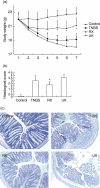
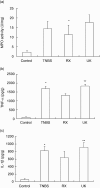
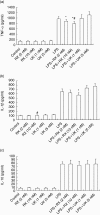
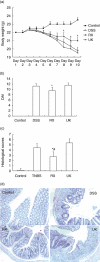
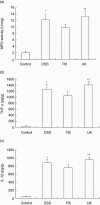
References
-
- Sartor RB. Mechanisms of disease: pathogenesis of Crohn's disease and ulcerative colitis. Nat Clin Pract Gastroenterol Hepatol. 2006;3:390–407. - PubMed
-
- Xavier RJ, Podolsky DK. Unravelling the pathogenesis of inflammatory bowel disease. Nature. 2007;448:427–34. - PubMed
-
- Irving PM, Shanahan F, Rampton DS. Drug interactions in inflammatory bowel disease. Am J Gastroenterol. 2008;103:207–19. - PubMed
-
- de Boer NK, van Bodegraven AA, Jharap B, de Graaf P, Mulder CJ. Drug insight: pharmacology and toxicity of thiopurine therapy in patients with IBD. Nat Clin Pract Gastroenterol Hepatol. 2007;4:686–94. - PubMed
-
- Tracey KJ. The inflammatory reflex. Nature. 2002;420:853–9. - PubMed
Publication types
MeSH terms
Substances
LinkOut - more resources
Full Text Sources
Research Materials
Miscellaneous

